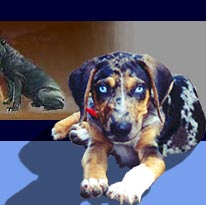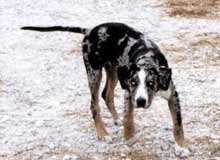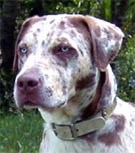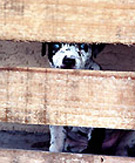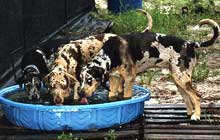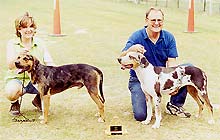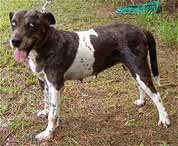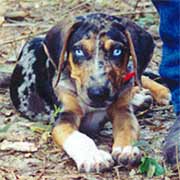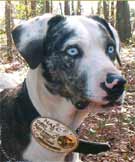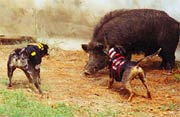Catahoula Leopard Dog
(part 2)
concept of children since puppyhood. A Catahoula also tends to be a clown and will join any activity whatever it may be. The main physical characteristic of the Catahoula Leopard Dog is its coat. The term "Leopard" refers to the merle color pattern. The merle pattern breaks up the dog's color, so that some hairs lack pigment. The
overall effect is a dilution of color, with some unaffected patches of dense color scattered throughout the coat. Blue Leopard, refers to the blue merle color pattern. Blue leopards may range from mostly grey to mostly black. Sometimes the terms "grey leopard" or "black leopard" are used. Red Leopard, refers to the red merle color pattern. Red leopards are some shade of light reddish-brown with darker
The Catahoula's coat may also be of the patchwork type. Patchwork, refers to leopards with patches of several different shades in their coats.
The Catahoula leopard dog's sense of ownership and commitment is such that any person who has a Catahoula says you don't own a Catahoula dog, but he owns you. He is your self appointed guardian whether you like it or not. Your children are his children and he takes this very seriously. Catahoula dogs are very wary of strangers. but are at home with children on condition, like any other dog breed, that they have been introduced to the
The background color may be white or very light, and the patches are usually large and scattered in such a way as to give a more torn or blotchy appearance than that of a typical leopard dog.
red or brown patches scattered throughout the coat. Sometimes the terms "brown leopard" or "chocolate leopard" are used.
Catahoula is referred to as being "white", it means that the dog is primarily white with some areas of leopard coloration. White dogs are generally the result of being "double merle" (carrying two copies of the merle gene). White dogs often have hearing or vision problems.
This pattern is similar to the harlequin pattern seen in Great Danes. Patchworks may be blue/black based or red based. Usually, when a
The other typical physical characteristic of the Catahoula Leopard Dog, besides his "leopard" coat, are the color of his eyes. The eye color may be brown, green, amber, blue or blue-white.
Facahatchee's War cloud
Facahatchee Catahoulas
Blue or blue-white are commonly referred to as Glass. Dogs with two glass eyes are often referred to as having "double glass eyes". Sometimes a glass eye will have darker colored sections in it and vice versa.
When both colored and glass portions are present in the same eye, it is usually called "cracked glass" or "marbled glass". Cracked eyes may be half of one color and half of another, or they may just have a streak or spot of another color. Gray eyes are usually cracked eyes, made of blue and green, giving them their greyish appearance. The eyes may be of the same color or each of a different color.
Last but not least of the typical physical characteristics are the feet of the Catahoula.
One of the major genetic flaws in this breed is deafness. A Catahoula that is predominantly white, or a white faced dog with glass eyes, has an 80% chance of being bi-laterally or uni-laterally deaf. This means that the dog will either be deaf in both ears, or, have hearing in one of its ears. Uni-lateral hearing is also referred to as "directional deafness". Care should be taken when acquiring a Catahoula with these visible traits. Test the dog with noises and sounds such as squeakers, clickers, or have it checked by a veterinarian.
The Catahoula Leopard Dog specialist Don Abney tells the following story, which emphasizes the selectiviness with which this breed has been "programmed" along the lines. It describes how and when, i.e. under what condition, hunters and Catahoula owners bred their dogs. "The breeding was to replace the dogs that were lost during a hunt, better the ones they had, or used in trading for other things that were needed.
The feet are webbed very similar to that of a duck. Unlike the webbing between the toes of most dogs, the web of a Catahoula is very prominent and extends almost to the end of the toes. This fully webbed foot enables the Catahoula to work soft marshy areas very easily, and aids them in being great swimmers.
There was a method used by hunters that was effective in producing the best hunting dogs. That method, if it were used today, would bring outcries of cruelty from animal rights groups. The method has been called "Culling" or "Lining". These are the two references I have heard the most. The manner of "Lining" was for an owner to take up a position where he knew deer had been crossing. An entire litter of approximately 6 months of age would be brought to that location. The dogs would be enticed to track the deer and then released as a pack The last two to cross the "Line" taken up by the owner were shot. The reason for this was that the dogs did not show enough interest in doing their job. The rest of the litter was allowed to go about tracking and/or baying the scent of the deer. As they returned, the first two to cross the line were also shot. The reasoning for this was that they didn't show enough interest to remain with the pack. The remaining dogs were considered the most promising dogs and would be raised up to adults and put to work. This practice would continue from season to season and litter to litter. It would insure that only the best dogs were kept for hunting and breeding. In those days, hunting was not just a sport. It put food on the table. Working a ranch dog meant not having to pay someone to help with rounding up or herding cattle. It didn't make any sense to keep and feed a dog that didn't do the job and do it well." (Don Abney, Abney Catahoulas)
.
.
.
Facahatchee's Catahoulas having fun
Photo courtesy: Lynn Jessmon
Nikki Ott and Don Abney with"Strike" & "Gipsy"
Photo courtesy: Nikki Ott
CH. Abney's Greyfeather
Abney Catahoulas
Photo courtesy: Don Abney
Crane's Strike Two as a puppy
Double Ott Catahoulas
Look at those eyes!
Facahatchee Catahoulas
Photo: Lynn Jessmon
Facahatchee's Chili Twist
Facahatchee Catahoulas
Photo: Lynn Jessmon
Facahatchee's Jewel
Facahatchee Catahoulas
Photo: Lynn Jessmon
Dixie and Strike
Double Ott Catahoulas
Dog breeds books featuring the Catahoula Leopard Dog:
As far as we know the following book is the only monograph published on the Catahoula Leopard Dog.
The Atlas of Dog Breeds of the World



